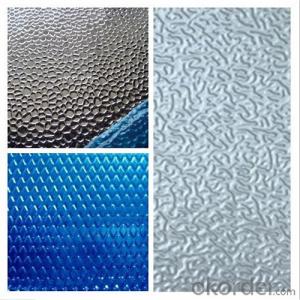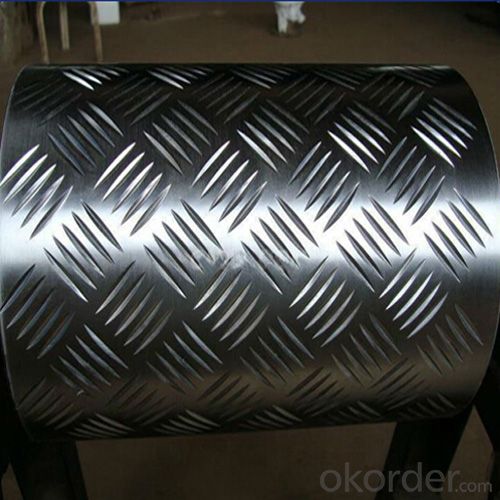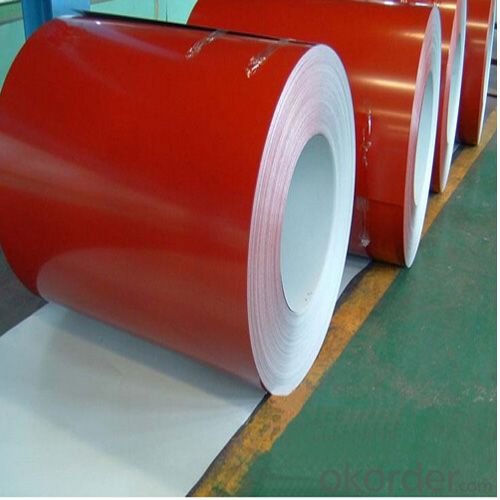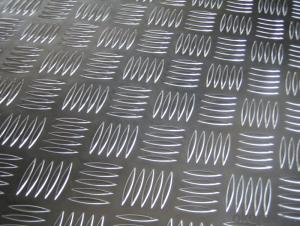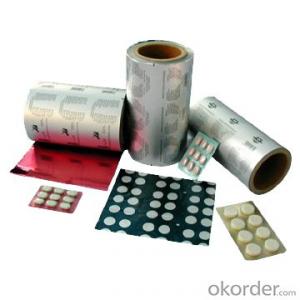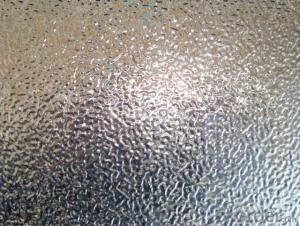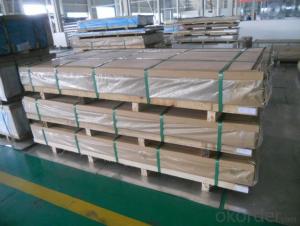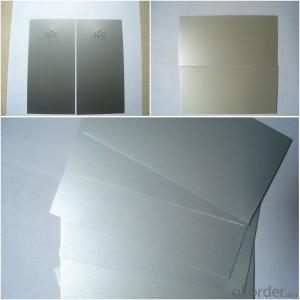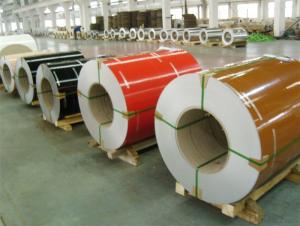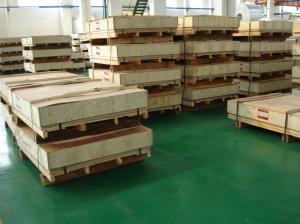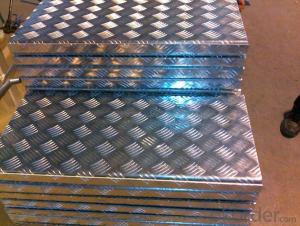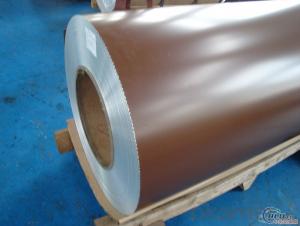Copper Colored PVDF Embossed Diamond Coated Aluminum Sheet
- Loading Port:
- Shanghai
- Payment Terms:
- TT OR LC
- Min Order Qty:
- 5 m.t.
- Supply Capability:
- 10000 m.t./month
OKorder Service Pledge
OKorder Financial Service
You Might Also Like
Specification
1.Structure of PE PVDF Embossed Diamond Color Coated Aluminum Sheet Description:
PE PVDF Embossed Diamond Color Coated Aluminum Sheets are widely used for building use, decoration use, making cookware, busing making, shipping building, airplane making and so on。Sizes of aluminum sheet for decoration use: Thickness: 0.3mm~300mm Width: Under 2000mm ( Standard: 1000mm, 1219mm, 1500mm, 1540mm) Length: Under 10000mm. Products commonly used in signs, billboards, building exterior decoration, bus body, high factory wall decoration, kitchen sink, lamp, fan, electronic components, chemical apparatus, sheet processing, deep drawing or spinning hollow ware, welding parts, heat exchangers, Bell surface and plate, plates, kitchen utensils, accessories, safety equipment and other.
2.Main Features of PE PVDF Embossed Diamond Color Coated Aluminum Sheet:
Thickness: 0.20mm-8.0mm(Coil), up to 320mm(Sheet/Plate)
Width: 8mm-2400mm
Temper: H1X, H2X, H3X, O, HXXX all available
Continuous casting and hot rolled both available
3. PE PVDF Embossed Diamond Color Coated Aluminum Sheet Images:
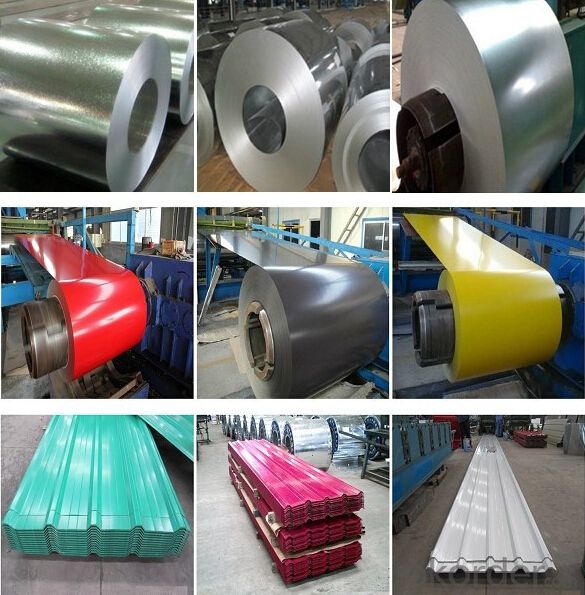
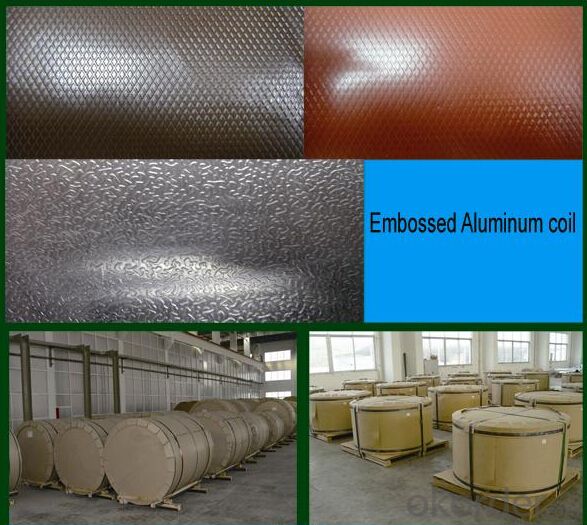
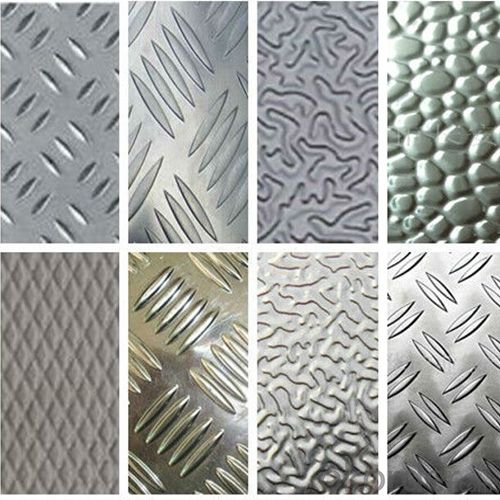
4. PE PVDF Embossed Diamond Color Coated Aluminum Sheet Specification:
| Aluminium sheet | |||||
| Alloy No. | Thickness (mm) | Width (mm) | Length (mm) | Temper | |
| A1050,A1060, A1070,A1100 | 0.2-100 | 20-2200 | 20-8000 | O,H12,H22,H14,H16,H18, H24,H26,etc | |
| 3A21,A3003,A3105,A3004 | 0.2-100 | 20-2200 | 20-8000 | O,H14,H18,H24,etc | |
| A5052 ,A5005,A5083,A5754 | 0.2-100 | 20-2200 | 20-8000 | O,H18,H24,H32,H34,H111,H112 ,etc | |
| A6061,A6082,A6063 | 0.2-200 | 20-2200 | 20-8000 | T4,T6, T651,etc | |
| A8011 | 0.2-100 | 20-2200 | 20-8000 | O,H12,H22,H14,H16,H18,H24,H26, etc | |
5.FAQ
Q1.How long have you been in this product?
A1:More than 10 years.
Q2. What's the minium quantity(MOQ)?
A2. 5 Metric tons
Q3. How long is shipping time?
A3. 7 (ready-made products)-25 days(OEM)
Q4. How do you guarantee the quality?
A4. 1. Cooperating and Exchaning experience with sevral quoted aluminum companies
2. Japanese and Swiss production line and skilled works (regular training and testing)
3. more than 10 years production experience.
Q5. Do you have after sale service?
A5. Yes. Any quality problem occurs within one year, pls take photoes,we will be responsible.
- Q: Are the aluminum sheets suitable for manufacturing automotive parts?
- Automotive parts can be effectively manufactured using aluminum sheets. This material, known for its lightweight and durability, provides several advantages in automotive applications. With a high strength-to-weight ratio, it is ideal for producing parts that require strength without burdening the vehicle with excessive weight. Aluminum sheets find widespread use in the production of automotive body panels, including hoods, doors, and fenders. Their malleability facilitates easy shaping and forming, enabling manufacturers to create intricate designs and complex details. Moreover, aluminum exhibits excellent corrosion resistance, ensuring longevity and reduced maintenance for the automotive parts made from it. In addition, aluminum's exceptional thermal conductivity makes it a suitable choice for components that necessitate heat dissipation, such as radiators and heat exchangers. Its ability to conduct electricity also renders it valuable in the manufacturing of electrical components for vehicles. Overall, the utilization of aluminum sheets in automotive manufacturing offers numerous benefits. Their lightweight nature enhances fuel efficiency, while their strength and durability guarantee the structural integrity of the vehicle. Furthermore, aluminum's corrosion resistance and thermal conductivity make it a reliable option for a variety of automotive parts.
- Q: Are aluminum sheets fire-resistant?
- Aluminum sheets are not inherently fire-resistant, but they do have properties that make them more fire-resistant compared to other materials. Aluminum has a high melting point of 1220°F (660°C), which means it will not ignite or burn easily under normal conditions. Additionally, aluminum has a low ignition temperature and does not release flammable gases when heated. When exposed to fire, aluminum sheets form a protective oxide layer that acts as a barrier, preventing further combustion and slowing down the spread of flames. This oxide layer also helps to insulate the aluminum from the heat, reducing the risk of structural failure. However, it is important to note that while aluminum sheets have better fire resistance than materials like wood or plastic, they can still be damaged or deformed by intense heat. Therefore, it is crucial to consider other fire safety measures, such as using fire-resistant coatings or implementing fire suppression systems, in order to ensure maximum protection against fire hazards.
- Q: Are the aluminum sheets suitable for manufacturing electronics components?
- Absolutely, aluminum sheets are a perfect fit for the production of electronic components. Aluminum, being a lightweight, durable, and reasonably priced material, finds extensive usage in the electronics sector. Its remarkable electrical conductivity is crucial for the efficient operation of electronic devices. Moreover, aluminum sheets can effortlessly be molded, trimmed, and fashioned into diverse components like heat sinks, enclosures, and connectors. Furthermore, aluminum boasts commendable thermal conductivity, enabling it to proficiently disperse heat generated by electronic components. Consequently, aluminum sheets emerge as an optimal selection for the manufacturing of electronic components.
- Q: What are the various types of insulation materials that can be combined with aluminum sheets for thermal or acoustic insulation purposes?
- <p>There are several types of insulation that can be used in conjunction with aluminum sheets, including: 1. Polyurethane foam, which provides excellent thermal insulation and can be bonded to aluminum sheets. 2. Mineral wool, a fire-resistant material that offers both thermal and acoustic insulation. 3. Polyisocyanurate, known for its high R-value and can be laminated to aluminum for added strength. 4. Extruded polystyrene, which is lightweight and provides good thermal resistance. 5. Fiberglass, a versatile insulation material that can be combined with aluminum for various applications. Each type has its specific properties and applications, making them suitable for different environments and insulation needs.</p>
- Q: What is the most efficient and low cost method for welding 1mm-3mm aluminum sheet?,What's new?
- If the cost is low, or belongs to the welding; and to stress the process of words, or to inert gas welding (TIG or MIG), and can use tungsten arc alternating current arc welding or tungsten arc argon arc welding.
- Q: Aluminum or steel bike frame cost more???...which one cost the most usually???
- Good quality steel frames are almost always more expensive than aluminum. There are a couple of reasons for this... 1) Aluminum is always welded. This takes much less effort and time than a fine brazed steel unit; 2) High quality steel tubing is very expensive compared to aluminum due to the thin walls and sometimes exotic alloying materials; 3) Aluminum is one of the most common elements on the planet. Common steel alloys have harder-to-obtain elements such as molybdneum, manganese, and other rare metals. 4) Although many aluminums require post weld processing it takes little or no labor to complete it while a high quality steel frame responds beautifully to hand work. 5) A good steel frame is simply harder to find nowadays. I know that this goes beyond the scope of your question, but keep in mind that regardless of the aluminum alloy it all weighs the same; regardless of the steel alloy it all weighs the same. The difference in weight comes from modifying the metal mixture, enabling a stronger metal and making of ever-thinner tubes. Kojman47 (below) is WAAY off in his interpretation of materials. There are steel frames that rival the weight and strength of titanium which is often 1/2 the weight of aluminum. There is no such thing as cromolly. The correct name (if I may) is Chrome Molybdneum, abbreviated as CrMo, often called Chrome Moly. Cromoly or cromolly or cromo doesn't give proper respect to the alloy OR to the frame. CrMo (cromolly in Kojmans eyes) is steel.
- Q: How do you ensure the flatness of large aluminum sheets?
- To ensure the flatness of large aluminum sheets, there are several key steps that can be taken: 1. Material selection: Start by choosing high-quality aluminum sheets that are specifically manufactured for flatness. These sheets should have consistent thickness and minimal internal stress to minimize the chances of warping. 2. Proper storage: Store the aluminum sheets in a controlled environment to avoid exposure to extreme temperature fluctuations or humidity. This will help prevent any potential expansion or contraction of the metal, which can lead to warping. 3. Handling and transportation: When moving or transporting the aluminum sheets, ensure that they are supported evenly to prevent any bending or flexing. Use appropriate lifting and handling equipment to avoid excessive strain on the sheets. 4. Machining and processing: During the machining and processing steps, it is crucial to use proper techniques and equipment to maintain flatness. Employ precision machinery that is capable of handling large sheets and has features to minimize distortion or bending during cutting, drilling, or forming processes. 5. Heat treatment: If necessary, heat treatment can be employed to relieve any residual stress in the aluminum sheets. Thermal stress relief techniques, such as annealing, can help reduce internal stress and improve flatness. 6. Quality control: Implement a rigorous quality control process to ensure the flatness of the aluminum sheets. This can include regular inspections using precision measuring instruments, such as straightedges or laser scanners, to detect any deviations from flatness. If any issues are identified, corrective actions can be taken promptly. By following these steps, manufacturers can ensure the flatness of large aluminum sheets, which is crucial for various industries such as aerospace, automotive, construction, and manufacturing.
- Q: Can aluminum sheets be used for roof flashing?
- Yes, aluminum sheets can be used for roof flashing. Aluminum is a popular choice for roof flashing due to its durability, corrosion resistance, and lightweight properties. It provides a reliable barrier against water penetration and helps to redirect water away from vulnerable areas on the roof, such as valleys and chimneys. Additionally, aluminum flashing is relatively easy to install and maintain, making it a practical choice for roof flashing purposes.
- Q: Can aluminum sheets be used for heat exchangers?
- Yes, aluminum sheets can be used for heat exchangers. Aluminum is a highly efficient conductor of heat, making it an ideal material for heat exchangers. Its high thermal conductivity allows for excellent heat transfer between fluids, resulting in efficient heat exchange. Additionally, aluminum sheets are lightweight, corrosion-resistant, and have good mechanical properties, further contributing to their suitability for heat exchanger applications.
- Q: Can 101 aluminum sheets be polished to a mirror-like finish?
- A mirror-like finish can be achieved on 101 aluminum sheets. Aluminum, being a lightweight and highly malleable metal, can be easily polished to obtain a reflective surface. Nevertheless, achieving a mirror-like finish on aluminum requires several steps and the use of appropriate polishing techniques and materials. To achieve a mirror-like finish on aluminum sheets, it is customary to begin by thoroughly cleaning the surface to eliminate any dirt, debris, or oxidation. Following that, sanding the surface with progressively finer sandpaper grits is necessary to eliminate imperfections or scratches. This step is vital in order to create a smooth and uniform surface that can be polished to a high level of shine. Once the sanding is completed, the polishing stage comes into play. There are various methods and materials available for polishing aluminum, such as abrasive compounds, buffing wheels, and polishing pads. These tools are utilized to exert pressure and friction on the aluminum surface, effectively removing any remaining scratches or imperfections and resulting in a smooth, reflective finish. Ultimately, to achieve a genuine mirror-like finish, the process of buffing or burnishing is often employed. This entails applying a polishing compound to the aluminum surface using a soft cloth or a specialized buffing wheel. The compound further refines the surface and enhances its reflective properties, ultimately leading to a mirror-like finish. It is important to note that achieving a mirror-like finish on aluminum can be a time-consuming and labor-intensive process, particularly when dealing with a large quantity of sheets like 101. Additionally, the quality of the aluminum sheets themselves and the skill level of the individual performing the polishing can also impact the final outcome. Nevertheless, with the right materials, techniques, and patience, it is indeed possible to polish 101 aluminum sheets to a mirror-like finish.
Send your message to us
Copper Colored PVDF Embossed Diamond Coated Aluminum Sheet
- Loading Port:
- Shanghai
- Payment Terms:
- TT OR LC
- Min Order Qty:
- 5 m.t.
- Supply Capability:
- 10000 m.t./month
OKorder Service Pledge
OKorder Financial Service
Similar products
Hot products
Hot Searches
Related keywords
